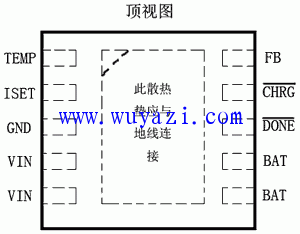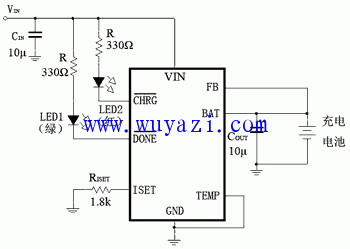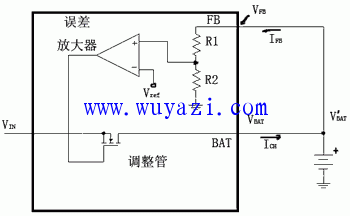Lithium iron phosphate battery charger CN3059
The lithium iron phosphate battery is a new type of lithium ion battery using lithium iron phosphate (LiFePO4) material as the positive electrode of the battery and graphite as the negative electrode of the battery. For a detailed introduction of the battery, please refer to the article 9 issue of lithium iron phosphate power battery.
The nominal voltage of the lithium iron phosphate battery is 3.2V, the termination charging voltage is 3.6±0.05V, and the termination discharge voltage is 2.0V. The battery requires constant current and constant voltage charging as the lithium ion battery, and the charging rate ranges from 0.2 to 1C.
After the independent development of single-cell lithium electronic charger chips CN3052 and CN3056, Shanghai Ruyun Electronics Co., Ltd. developed a better single-node lithium iron phosphate charger chip CN3058 and CN3059 in 2007 to meet the market demand. This article will introduce CN3059.
Features and applications
CN3059 is a charger IC for constant current and constant voltage charging of a single lithium iron phosphate battery. Main features of the charger composed of the IC: The charging current can be set by a peripheral resistor RISET, the maximum charging current can reach 1A; the input voltage is 4~6V, and the USB interface or 4.5~6V output voltage can be used (output current 1000~1500mA) AC/DC adapter power supply; charger circuit is simple, few peripheral components, low cost; for over-discharge (battery voltage <2.0V) battery has a small current pre-charge mode; internal power processor circuit, if the chip When the junction temperature exceeds 115 °C, the charging current can be automatically reduced for overheat protection, so that the user can set a larger charging current to improve the charging efficiency; there are two LEDs for charging state indication and charging end indication; the input voltage is too low ( Output latch function at <3.61V), automatic recharge function, battery temperature monitoring function; 10-pin DFN package with small size and heat dissipation enhancement; charging temperature range 0~45°C or 0~65°C (by charging Battery parameters are determined).
CN3059 is a dedicated charger IC for lithium iron phosphate battery, but it also has a unique feature: a resistor RVSET peripheral, which can increase the output voltage of constant voltage charging. With this unique feature, you can make a simple 3-cell NiMH battery charger and a 4V lead-acid battery charger or a Li-Ion battery charger.
The charger consisting of CN3059 is suitable for charging lithium iron phosphate batteries of 0.5~4Ah. Its application areas: miner's lamp, LED emergency light, warning light; car model, ship model, model airplane and electric toy; in the camera, replace the disposable 3V lithium battery (model CR123A) with 3.2V lithium iron phosphate battery, its outer dimensions The same; communication devices; small medical instruments and field test instruments; small power tools. In addition, CN3059 can be used to form a charger for charging a 3-cell NiMH battery and a 4V lead-acid battery.
Package, pinout and function
The CN3059 is available in a thermally enhanced 10-pin small DFN package with pinouts as shown in Figure 1. The function of each pin is shown in Table 1. 
The main parameters
The limit parameter of CN3059: the voltage range of each pin is -0.3~6.5V; the short circuit time of BAT pin and GND can be continuous; the electrostatic breakdown voltage is 2kV; the maximum junction temperature is 150°C; the soldering temperature is 300°C (10s) .
The electrical parameters of CN3059: power supply input voltage range is 4~6V; quiescent current is 650μA; low voltage latch voltage is VIN≤3.61V; pre-stored threshold voltage is battery voltage less than 2.05V; constant voltage charging voltage is 3.6V; End threshold voltage (ISET terminal voltage) is 0.22V; sleep mode threshold voltage is VIN-VBAT≤20mV; sleep mode release threshold voltage is VIN-VBAT≥50mV; TEMP terminal high temperature threshold voltage is 80%VIN, low temperature threshold voltage is 48 % VIN.
The typical application circuit uses CN3059 to form a lithium iron phosphate battery charger circuit and a lithium ion charger circuit composed of CN3056. The former has two outstanding advantages: 1 accurately detecting the voltage of the rechargeable battery, and controlling the termination charging voltage of the rechargeable battery. More accurate, make the battery charge more full; 2 use a resistor RVSET between the FB end and the battery positive electrode, so that the charger can be charged with lead-acid battery and nickel-hydrogen in addition to the lithium iron phosphate battery. The battery expands the charger function. The two typical application circuits are described below.
1. Lithium iron phosphate battery circuit The rechargeable battery model is 26650, the capacity is 2800mAH, and 1000mA constant current charging is used (the charging rate is about 0.36C). The charger circuit is shown in Figure 2. 
Figure 3 general battery voltage detection circuit 
Previous: External conversion circuit when DAC0832 outputs analog voltage
Next:32W fluorescent lamp ballast circuit diagram
Related Reading Tools Lithium Battery Power Battery Rechargeable Battery Cable
- • [New product broadcast] 1N212 2016-08-10 14:18
- • [New product broadcast] 1N203 2016-08-10 14:18
- • [New product broadcast] 1N202 2016-08-10 14:18
- • [New product broadcast] 1N194A 2016-08-10 14:18
- • [New product broadcast] 1N78C 2016-08-10 14:18
- • [New product broadcast] 1N76C 2016-08-10 14:18
- • [New product broadcast] 1N58A 2016-08-10 14:18
- • [New product broadcast] 1N56A 2016-08-10 14:18
everyone enjoys luck , https://www.eeluck.com
![<?echo $_SERVER['SERVER_NAME'];?>](/template/twentyseventeen/skin/images/header.jpg)